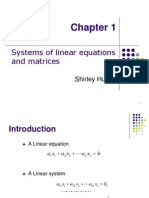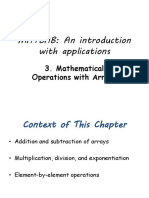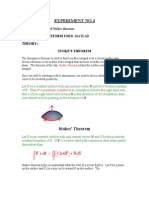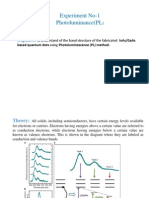Tutorial 2-3. Contents
Uploaded by
jawaidaligTutorial 2-3. Contents
Uploaded by
jawaidaligMath for CS Tutorial 2-3 1
Solution of Systems of Linear Equations
Gaussian Elimination
LU Decomposition
Gram-Schmidt vector orthogonalization
Tutorial 2-3. Contents
Math for CS Tutorial 2-3 2
Linear Systems in Matrix Form
n n nn n n
n n
n n
b x a x a x a
b x a x a x a
b x a x a x a
= + + +
= + + +
= + + +
2 2 1 1
2 2 2 22 1 21
1 1 2 12 1 11
(
(
(
(
=
(
(
(
(
(
(
(
(
n n nn n n
n
n
b
b
b
x
x
x
a a a
a a a
a a a
2
1
2
1
2 1
2 22 21
1 12 11
Linear equation means that every variable is in the power 1 only.
If the variables in the equation are ordered x
1
, x
n
and the missing variables
x
i
are written as + 0x
i
+ , then the linear equation can be written in the
matrix notation, according to the matrix multiplication rules. Solution of linear
equations was one of the reasons, for matrix notation invention.
(1)
Math for CS Tutorial 2-3 3
An inconsistent example:
Geometric interpretation
(
=
(
5
4
4 2
2 1
2
1
x
x
(
0 0
2 1
Rank{A}=1
Rank{A|b}=2 Rank{A}
ERO:Multiply the first row with
-2 and add to the second row
(
3
4
0
2
0
1
Math for CS Tutorial 2-3 4
Full-rank systems
If Rank{A}=n
Det{A} = 0 A
-1
exists Unique solution
(
=
(
2
4
1 1
2 1
2
1
x
x
Math for CS Tutorial 2-3 5
First step of elimination
(
(
(
(
(
(
=
(
(
(
(
(
(
(
(
(
(
(
(
=
=
=
) 2 (
) 2 (
3
) 2 (
2
) 1 (
1
3
2
1
) 2 ( ) 2 (
3
) 2 (
2
) 2 (
3
) 2 (
33
) 2 (
32
) 2 (
2
) 2 (
23
) 2 (
22
) 1 (
1
) 1 (
13
) 1 (
12
) 1 (
11
) 1 (
11
) 1 (
1 1 ,
) 1 (
11
) 1 (
31 1 , 3
) 1 (
11
) 1 (
21 1 , 2
0
0
0
/
/
/
n
n
nn n n
n
n
n
n n
b
b
b
b
x
x
x
x
a a a
a a a
a a a
a a a a
a a m
a a m
a a m
(
(
(
(
(
(
=
(
(
(
(
(
(
(
(
(
(
(
(
) 1 (
) 1 (
3
) 1 (
2
) 1 (
1
3
2
1
) 1 ( ) 1 (
3
) 1 (
2
) 1 (
1
) 1 (
3
) 1 (
33
) 1 (
32
) 1 (
31
) 1 (
2
) 1 (
23
) 1 (
22
) 1 (
21
) 1 (
1
) 1 (
13
) 1 (
12
) 1 (
11
n
n
nn n n n
n
n
n
b
b
b
b
x
x
x
x
a a a a
a a a a
a a a a
a a a a
Pivotal element
Math for CS Tutorial 2-3 6
Second step of elimination
(
(
(
(
(
(
=
(
(
(
(
(
(
(
(
(
(
(
(
=
=
) 3 (
) 3 (
3
) 2 (
2
) 1 (
1
3
2
1
) 3 ( ) 3 (
3
) 3 (
3
) 3 (
33
) 2 (
2
) 2 (
23
) 2 (
22
) 1 (
1
) 1 (
13
) 1 (
12
) 1 (
11
) 2 (
22
) 2 (
2 2 ,
) 2 (
22
) 2 (
32 2 , 3
0 0
0 0
0
/
/
n
n
nn n
n
n
n
n n
b
b
b
b
x
x
x
x
a a
a a
a a a
a a a a
a a m
a a m
(
(
(
(
(
(
=
(
(
(
(
(
(
(
(
(
(
(
(
) 2 (
) 2 (
3
) 2 (
2
) 1 (
1
3
2
1
) 2 ( ) 2 (
3
) 2 (
2
) 2 (
3
) 2 (
33
) 2 (
32
) 2 (
2
) 2 (
23
) 2 (
22
) 1 (
1
) 1 (
13
) 1 (
12
) 1 (
11
0
0
0
n
n
nn n n
n
n
n
b
b
b
b
x
x
x
x
a a a
a a a
a a a
a a a a
Pivotal element
Math for CS Tutorial 2-3 7
Back substitution algorithm
(
(
(
(
(
(
(
(
=
(
(
(
(
(
(
(
(
(
(
(
(
(
(
(
(
) (
) 1 (
1
) 3 (
3
) 2 (
2
) 1 (
1
1
3
2
1
) (
) (
1
) (
1 1
) 3 (
3
) 3 (
33
) 2 (
2
) 2 (
23
) 2 (
22
) 1 (
1
) 1 (
13
) 1 (
12
) 1 (
11
0 0 0 0
0 0 0
0 0
0
n
n
n
n
n
n
n
nn
n
n n
n
n n
n
n
n
b
b
b
b
b
x
x
x
x
x
a
a a
a a
a a a
a a a a
| |
1 , , 2 , 1
1
1
1
) ( ) (
) (
1
1
) 1 (
1
) 1 (
1 1
1
) (
) (
=
(
=
= =
+ =
n n i x a b
a
x
x a b
a
x
a
b
x
n
i k
k
i
ik
i
i
i
ii
i
n
n
n n
n
n
n
n n
n
n
nn
n
n
n
Math for CS Tutorial 2-3 8
LU Decomposition
A=LU
Ax=b LUx=b
Define Ux=y
Ly=b Solve y by forward substitution
EROs must be performed on b as well as A
The information about the EROs are stored in L
Indeed y is obtained by applying EROs to b vector
Ux=y Solve x by backward substitution
Math for CS Tutorial 2-3 9
LU Decomposition by Gaussian
elimination
(
(
(
(
(
(
(
(
(
(
(
(
(
(
(
(
=
) (
) (
1
) (
1 1
) 3 (
3
) 3 (
33
) 2 (
2
) 2 (
23
) 2 (
22
) 1 (
1
) 1 (
13
) 1 (
12
) 1 (
11
4 , 3 , 2 , 1 ,
3 , 1 2 , 1 1 , 1
2 , 3 1 , 3
1 , 2
0 0 0 0
0 0 0
0 0
0
1
1
0
0 0 1
0 0 0 1
0 0 0 0 1
n
nn
n
n n
n
n n
n
n
n
n n n n
n n n
a
a a
a a
a a a
a a a a
m m m m
m m m
m m
m
A
Compact storage: The diagonal entries of L matrix are all 1s,
they dont need to be stored. LU is stored in a single matrix.
There are infinitely many different ways to decompose A.
Most popular one: U=Gaussian eliminated matrix
L=Multipliers used for elimination
Math for CS Tutorial 2-3 10
An example: Linear System
(
(
(
=
(
(
(
(
(
(
29
20
14
6 4 3
4 3 2
3 2 1
3
2
1
x
x
x
Rank{A}=n A
-1
exists Unique solution
Math for CS Tutorial 2-3 11
Gaussian Elimination
(
(
(
(
(
(
(
(
(
3
8
14
1 0 0
2 1 0
3 2 1
13
8
14
3 2 0
2 1 0
3 2 1
29
20
14
6 4 3
4 3 2
3 2 1
x
3
=3;
-x
2
-2x
3
=-8;
x
2
=2;
x
1
+2*2+3*3=14;
x
1
=14-4-9=1.
Math for CS Tutorial 2-3 12
LU Factorization
b L x U
b L x A L
LU A
b x A
1
1 1
=
=
=
=
(
(
(
(
(
(
(
(
(
(
(
(
(
(
(
(
(
(
3
8
14
1 0 0
2 1 0
3 2 1
1 2 1
0 1 2
0 0 1
13
8
14
3 2 0
2 1 0
3 2 1
1 0 3
0 1 2
0 0 1
29
20
14
6 4 3
4 3 2
3 2 1
1 0 0
0 1 0
0 0 1
L
-1
U=L
-1
A
(
(
(
=
(
(
(
(
(
(
1 0 0
2 1 0
3 2 1
6 4 3
4 3 2
3 2 1
1 2 1
0 1 2
0 0 1
Check that there were no mistakes:
L
-1
A
U
Math for CS Tutorial 2-3 13
LU Factorization
(
(
(
=
(
(
(
(
(
(
1 0 0
2 1 0
3 2 1
6 4 3
4 3 2
3 2 1
1 2 1
0 1 2
0 0 1
Check that there were no mistakes:
L
-1
A
U
(
(
(
=
(
(
(
(
(
(
3
8
14
29
20
14
1 2 1
0 1 2
0 0 1
L
-1
b b
L
-1
x
3
=3;
-x
2
-2x
3
=-8;
x
2
=2;
x
1
+2*2+3*3=14;
x
1
=14-4-9=1.
Math for CS Tutorial 2-3 14
the Gram-Schmidt procedure
for vector orthogonalization
The purpose
we can construct a set of orthonormal
vectors u
i
from a set of n-dimensional
vectors v
i
. 1im
And v
i
can be represented by the linear
combination of u
i
Math for CS Tutorial 2-3 15
G-S procedure (cont.)
1. Select a vector from vi arbitrarily, say v1
2. By normalizing its length, we obtain the first vector, say
3. Select v2 and subtract the projection of v2 onto u1, we
get
w
2
=v
2
(v
2
u
1
)u
1
v
v
u
1
1
1
=
Math for CS Tutorial 2-3 16
G-S procedure (cont.)
4. And normalizing
5. Now we can check, that
0 , , , ,
2 1 2 1 1 1 , 2 2 1 2 1
= = = v u v u u u v v u u u
w
w
u
2
2
2
=
Math for CS Tutorial 2-3 17
G-S procedure (cont.)
6. The procedure continues by selecting v
3
and subtract
its projection on u
1
and u
2
, we have
w
3
=v
3
(v
3
u
1
)u
1
(v
3
u
2
)u
2
7. Then, the orthonormal vector u
3
is
8. By continuing this procedure, we shall construct the
set of orthonormal vectors u
i
w
w
u
3
3
3
=
Math for CS Tutorial 2-3 18
G-S procedure: Example
Consider v
1
=(0,1,1); v
2
=(1,-1,0); v
3
=(1,0,1)
They are not orthogonal: (v
i
,v
j
)0.
Following G-S:
) 1 , 1 , 0 (
2
1
1
= u
)
2
1
,
2
1
, 1 ( ) 1 , 1 , 0 (
2
1
) 0 , 1 , 1 ( ) 1 , 1 , 0 (
2
1
2
1
) 0 , 1 , 1 (
1 2 1 2 2
= + =
= = u v u v w
Math for CS Tutorial 2-3 19
Example (cont.)
)
2
1
,
2
1
, 1 (
3
2
)
2
1
,
2
1
, 1 (
2
2
2
= = =
w
w
u
0 )
2
1
2
1
0 (
3
1
2 1
= + = u u
We can check, that:
2 2 3 1 1 3 3 3
u u v u u v v w =
Math for CS Tutorial 2-3 20
Example (cont.)
)
2
1
,
2
1
, 1 (
3
2
)
2
1
0 1 (
3
2
) 1 , 1 , 0 (
2
1
2
1
) 1 , 0 , 1 (
3
|
|
.
|
\
|
+ + = w
)
2
1
,
2
1
, 1 ( )
2
1
,
2
1
, 0 ( ) 1 , 0 , 1 ( )
2
1
,
2
1
, 1 (
2
3
3
2
) 1 , 1 , 0 (
2
1
) 1 , 0 , 1 (
3
= = w
) 0 , 0 , 0 (
3
= w
Why?
You might also like
- Systems of Linear Equations and Matrices: Shirley HuangNo ratings yetSystems of Linear Equations and Matrices: Shirley Huang51 pages
- Two Equations 1x + 2y 3 Two Unknowns 4x + 5y 6No ratings yetTwo Equations 1x + 2y 3 Two Unknowns 4x + 5y 621 pages
- Cpe-310B Engineering Computation and Simulation: Solving Sets of EquationsNo ratings yetCpe-310B Engineering Computation and Simulation: Solving Sets of Equations46 pages
- Phd:304 Lab Report Advanced Mathematical Physics: Sachin Singh Rawat 16PH-06 (Department of Physics)No ratings yetPhd:304 Lab Report Advanced Mathematical Physics: Sachin Singh Rawat 16PH-06 (Department of Physics)12 pages
- Notes on Basic Linear Algebra 8 March 2022No ratings yetNotes on Basic Linear Algebra 8 March 202213 pages
- Matrices: Discrete Mathematical Structures: Theory and ApplicationsNo ratings yetMatrices: Discrete Mathematical Structures: Theory and Applications48 pages
- Chapter 1 Linear Equations and Linear TransformationsNo ratings yetChapter 1 Linear Equations and Linear Transformations44 pages
- MTH5112 Linear Algebra I, 2009-2010: Oscar Bandtlow 30 March 2010No ratings yetMTH5112 Linear Algebra I, 2009-2010: Oscar Bandtlow 30 March 2010108 pages
- MDB3053 Chap9 LinearAlgebra Part 1 May16No ratings yetMDB3053 Chap9 LinearAlgebra Part 1 May1627 pages
- CME 434 Notes - Matrix Equations: 1.1 Introduction To MatricesNo ratings yetCME 434 Notes - Matrix Equations: 1.1 Introduction To Matrices19 pages
- SNU - MAT260 - Linear Algebra 1_Amber HabibNo ratings yetSNU - MAT260 - Linear Algebra 1_Amber Habib61 pages
- An Introduction To Linear Algebra: Matrices and Linear SystemsNo ratings yetAn Introduction To Linear Algebra: Matrices and Linear Systems34 pages
- Analytic Geometry: Graphic Solutions Using Matlab LanguageFrom EverandAnalytic Geometry: Graphic Solutions Using Matlab LanguageNo ratings yet
- Equilibrium of Diffusion and Field Currents: 2.4.2 Debye LengthNo ratings yetEquilibrium of Diffusion and Field Currents: 2.4.2 Debye Length5 pages
- Sub: Request For Single Occupancy Room in Student HostelNo ratings yetSub: Request For Single Occupancy Room in Student Hostel1 page
- Angle Modulation - Frequency Modulation: φ + t ω V = t vNo ratings yetAngle Modulation - Frequency Modulation: φ + t ω V = t v45 pages
- Subj.:10B11EC511 LTP:L Group: ALL ALL Enrol No. Name of Student Reg. DateNo ratings yetSubj.:10B11EC511 LTP:L Group: ALL ALL Enrol No. Name of Student Reg. Date4 pages
- Experiment No.4: AIM:-Verification of Stokes Theorem Apparatus/Platform UsedNo ratings yetExperiment No.4: AIM:-Verification of Stokes Theorem Apparatus/Platform Used3 pages
- Metal Semiconductor Junction: Structure and Principle of OperationNo ratings yetMetal Semiconductor Junction: Structure and Principle of Operation3 pages
- Equilibrium of Diffusion and Field Currents: 2.4.2 Debye LengthNo ratings yetEquilibrium of Diffusion and Field Currents: 2.4.2 Debye Length5 pages
- Experiment No-1 Photoluminance (PL: ObjectiveNo ratings yetExperiment No-1 Photoluminance (PL: Objective10 pages
- Systems of Linear Equations and Matrices: Shirley HuangSystems of Linear Equations and Matrices: Shirley Huang
- Cpe-310B Engineering Computation and Simulation: Solving Sets of EquationsCpe-310B Engineering Computation and Simulation: Solving Sets of Equations
- Phd:304 Lab Report Advanced Mathematical Physics: Sachin Singh Rawat 16PH-06 (Department of Physics)Phd:304 Lab Report Advanced Mathematical Physics: Sachin Singh Rawat 16PH-06 (Department of Physics)
- Matrices: Discrete Mathematical Structures: Theory and ApplicationsMatrices: Discrete Mathematical Structures: Theory and Applications
- Chapter 1 Linear Equations and Linear TransformationsChapter 1 Linear Equations and Linear Transformations
- MTH5112 Linear Algebra I, 2009-2010: Oscar Bandtlow 30 March 2010MTH5112 Linear Algebra I, 2009-2010: Oscar Bandtlow 30 March 2010
- CME 434 Notes - Matrix Equations: 1.1 Introduction To MatricesCME 434 Notes - Matrix Equations: 1.1 Introduction To Matrices
- An Introduction To Linear Algebra: Matrices and Linear SystemsAn Introduction To Linear Algebra: Matrices and Linear Systems
- Analytic Geometry: Graphic Solutions Using Matlab LanguageFrom EverandAnalytic Geometry: Graphic Solutions Using Matlab Language
- Equilibrium of Diffusion and Field Currents: 2.4.2 Debye LengthEquilibrium of Diffusion and Field Currents: 2.4.2 Debye Length
- Sub: Request For Single Occupancy Room in Student HostelSub: Request For Single Occupancy Room in Student Hostel
- Angle Modulation - Frequency Modulation: φ + t ω V = t vAngle Modulation - Frequency Modulation: φ + t ω V = t v
- Subj.:10B11EC511 LTP:L Group: ALL ALL Enrol No. Name of Student Reg. DateSubj.:10B11EC511 LTP:L Group: ALL ALL Enrol No. Name of Student Reg. Date
- Experiment No.4: AIM:-Verification of Stokes Theorem Apparatus/Platform UsedExperiment No.4: AIM:-Verification of Stokes Theorem Apparatus/Platform Used
- Metal Semiconductor Junction: Structure and Principle of OperationMetal Semiconductor Junction: Structure and Principle of Operation
- Equilibrium of Diffusion and Field Currents: 2.4.2 Debye LengthEquilibrium of Diffusion and Field Currents: 2.4.2 Debye Length











































































